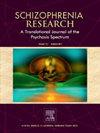Capturing changes in social functioning and positive affect using ecological momentary assessment during a 12-month trial of xanomeline and trospium chloride in schizophrenia
IF 3.6
2区 医学
Q1 PSYCHIATRY
引用次数: 0
Abstract
Background
Experiential negative symptoms (NS) are determinants of disability in schizophrenia (SCZ). Xanomeline/Trospium Chloride (X/T), an M1/M4 muscarinic receptor agonist, is an approved monotherapy for treatment of schizophrenia, including NS. We used remote ecological momentary assessments (EMA) to track changes in indicators of NS during 12 months of outpatient treatment with X/T.
Methods
After discontinuing previous medications, 566 outpatients with SCZ received open-label X/T monotherapy for up to 12 months. Participants completed 3 EMA surveys 7 days a week, one week a month. Surveys queried whether participants were home vs. away and alone vs with someone, as well as productive and unproductive activities, and moods. Hierarchical linear modeling (HLM) examined temporal changes and the relationships between the indicators of NS.
Results
500 participants answered one or more EMA surveys and 350 met 33 % adherence criteria, answering a total of 40,464 surveys, with overall adherence among these participants at 66 %. During treatment with X/T, there were significant decreases in surveys at home (p < .001), alone (p < .001), and engaging in unproductive activities (p < .001). There were significant increases in productive activities both home (p < .001) and away (p < .001) and in positive affect (PA) (p < .001). Improvements in PA converged with reduced unproductive activities, particularly when others were present (p < .001).
Conclusions
Behavioral indicators of NS improved early and were sustained with X/T treatment. Improvements were multidimensional, shifting toward more time with others, away from home, and engaged in productive activities. These improvements were associated with increases in PA, consistent with previous EMA studies of NS.
求助全文
约1分钟内获得全文
求助全文
来源期刊

Schizophrenia Research
医学-精神病学
CiteScore
7.50
自引率
8.90%
发文量
429
审稿时长
10.2 weeks
期刊介绍:
As official journal of the Schizophrenia International Research Society (SIRS) Schizophrenia Research is THE journal of choice for international researchers and clinicians to share their work with the global schizophrenia research community. More than 6000 institutes have online or print (or both) access to this journal - the largest specialist journal in the field, with the largest readership!
Schizophrenia Research''s time to first decision is as fast as 6 weeks and its publishing speed is as fast as 4 weeks until online publication (corrected proof/Article in Press) after acceptance and 14 weeks from acceptance until publication in a printed issue.
The journal publishes novel papers that really contribute to understanding the biology and treatment of schizophrenic disorders; Schizophrenia Research brings together biological, clinical and psychological research in order to stimulate the synthesis of findings from all disciplines involved in improving patient outcomes in schizophrenia.
 求助内容:
求助内容: 应助结果提醒方式:
应助结果提醒方式:


